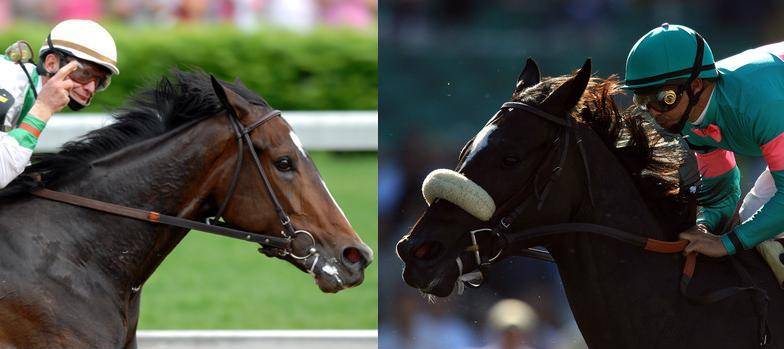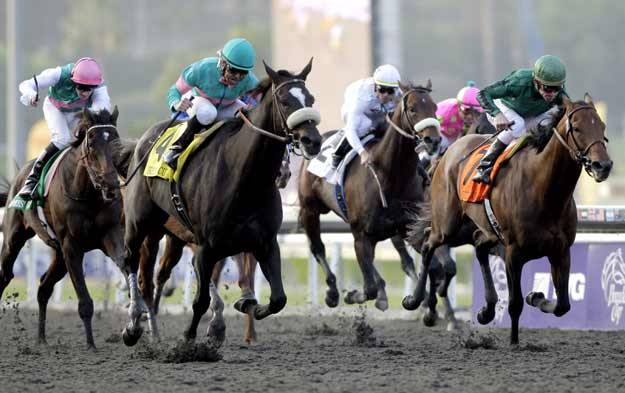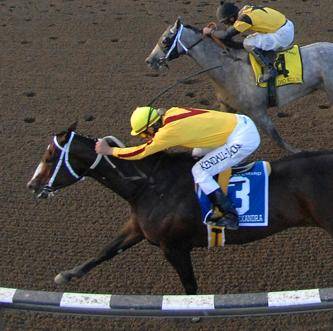 And so it begins. For months now, arguments have been hurled back and forth like a mud-slinging match between political parties, and I’ve tried to stay away. The fights have erred on insulting, and both sides have angered me with their accusations. If you’re at all tuned in to the horse racing world, you know this debate has become infamous: who deserves Horse of the Year, Rachel Alexandra or Zenyatta? Many articles have been writ on this subject—some thoughtful, some ridiculous—and since this article will be the year-end edition of The Call to the Post, I’ve decided to break my silence and give my final word about the two top contenders for the most coveted Eclipse Award. (That way, if I should die in my plane flight going to or coming from Santa Anita over the break, all of you will know how I truly stood on this topic, because obviously the masses have been waiting with baited breath far too long…)
And so it begins. For months now, arguments have been hurled back and forth like a mud-slinging match between political parties, and I’ve tried to stay away. The fights have erred on insulting, and both sides have angered me with their accusations. If you’re at all tuned in to the horse racing world, you know this debate has become infamous: who deserves Horse of the Year, Rachel Alexandra or Zenyatta? Many articles have been writ on this subject—some thoughtful, some ridiculous—and since this article will be the year-end edition of The Call to the Post, I’ve decided to break my silence and give my final word about the two top contenders for the most coveted Eclipse Award. (That way, if I should die in my plane flight going to or coming from Santa Anita over the break, all of you will know how I truly stood on this topic, because obviously the masses have been waiting with baited breath far too long…)
In order to make an intelligent opinion on this debate, one must know the facts of both sides. We will start with Zenyatta, then go on to Rachel, stating each’s attributes for why she should win the Eclipse for Horse of the Year, and then contrast their detractors.
Zenyatta completed a perfect season with 5 wins in 5 starts, four of them Grade I victories. She became the first female horse to win the Breeders’ Cup Classic when she won the race in her patented last-to-first running style, when challenged against males for the first time. The Classic was called one of the deepest fields in history, boasting a Kentucky Derby winner, a Belmont and Travers Stakes winner, an Arlington Million winner, as well as top stakes runners from Europe. The Classic was surely the biggest test in the 5-year-old mare’s career; not only did she break slowly and start on the wrong lead, but she had to come between horses with her furious late charge, something she’d never had to do before. As a big horse, standing at 17.1 hands, it’s very difficult to weave between traffic,  but Zenyatta did that and then some, going on to score America’s richest race by a length. And she did this like she was running against a bunch of mid-grade fillies, her ears pricking and without breaking a sweat. Zenyatta’s victory in the Breeders’ Cup Classic capped off a perfect career; she was retired unbeaten in 14-for-14 races. The popular mare brought the Santa Anita crowd to its knees in celebration; the presence, the power, and talent of Zenyatta is something unlike we’ll probably ever see again.
but Zenyatta did that and then some, going on to score America’s richest race by a length. And she did this like she was running against a bunch of mid-grade fillies, her ears pricking and without breaking a sweat. Zenyatta’s victory in the Breeders’ Cup Classic capped off a perfect career; she was retired unbeaten in 14-for-14 races. The popular mare brought the Santa Anita crowd to its knees in celebration; the presence, the power, and talent of Zenyatta is something unlike we’ll probably ever see again.
In the closest call of her career, Zenyatta won by a determined head in the 2009 edition of the Clement L. Hirsch Stakes at Del Mar. Her late running style nearly got her into trouble in that race, and perhaps her regular jockey, Mike Smith, was a little too confident going into it. Zenyatta hung dead last in the middle of the turn, and didn’t start to pick off horses until the rest of the field was beginning to turn for home. The stretch looked desperate as Zenyatta began to make her charge, her stride lengthening, Smith imploring her to dig deep for all she had, and it was with the heart of a champion she was able to get up to the wire and keep her record perfect by her tenacious head. In truth, it wasn’t Zenyatta’s fault the race finished so close; it was more like bad timing by her jockey. After the race, Smith acknowledged his error and marked the big mare still wasn’t blowing when she returned to the winner’s circle. Only human error, it seems, could make this champion come close to failure, but her class always shone in the end. Steve Haskin said it best in his article about Zenyatta after the Hirsch: “When you’re last in a field that is strung out a dozen lengths, and then they wind up going three-quarters in a sloth-like 1:13 3/5, and you’re still 4 1/2 lengths back at the eighth pole, and you have to come home in :23 1/5 and then a final sixteenth in about :05 3/5, and you get there, there is no doubt you are something special.”
Rachel Alexandra has also had a perfect season, winning 8 of 8 starts, five of them Grade I races; three of those races were won against males, one of those against older males. As a 3-year-old filly, Rachel Alexandra has accomplished feats never before recorded in modern times. She was also the first filly in 85 years to win the Preakness Stakes, the second leg of the Triple Crown; she won it coming out of post position #13, which no other horse had ever done before. She won the Kentucky Oaks by 20 ¼ lengths, the largest margin in the race’s history, and became the first Oaks winner to not only run in the Preakness, but to win both those races. No 3-year-old filly has ever gone against older males so early as Rachel did in her career and won, which she did in the Woodward. She set a new stakes record in the Grade I Mother Goose, and broke Ruffian’s record largest margin of 13 ½ lengths by 5 ¾ more. And she has done all of this in whatever running style the circumstances ask of her, whether it be front-running, from just off the pace, or coming from behind horses.
 Though an argument could be made for each of her tests against males as to which her best performance might be, most would contend the Woodward was Rachel’s most impressive victory, though she won it by a smaller margin than any other start in her 2009 season. Just as in Zenyatta’s Hirsch victory, which was her closest brush with defeat, Rachel won in her own unbelievable way; but instead of a nail-biting last-to-first dig to the wire like the 5-year-old mare, Rachel was forced through blistering fractions to not only set the pace, but to hold off the attacks of older males throughout the entire race, and finally, the late-charge of Stephen Foster winner, Macho Again. And just as in Zenyatta’s Hirsch, when the last few strides seemed too insurmountable to overcome, the champion found some way to clench victory before it could be yanked out of reach. In short, Rachel Alexandra has time and time again been put into a situation that stacks all odds against her, whether it be her age, her sex, her post position, or simply her running style, and all threats she has turned away with her guts and class.
Though an argument could be made for each of her tests against males as to which her best performance might be, most would contend the Woodward was Rachel’s most impressive victory, though she won it by a smaller margin than any other start in her 2009 season. Just as in Zenyatta’s Hirsch victory, which was her closest brush with defeat, Rachel won in her own unbelievable way; but instead of a nail-biting last-to-first dig to the wire like the 5-year-old mare, Rachel was forced through blistering fractions to not only set the pace, but to hold off the attacks of older males throughout the entire race, and finally, the late-charge of Stephen Foster winner, Macho Again. And just as in Zenyatta’s Hirsch, when the last few strides seemed too insurmountable to overcome, the champion found some way to clench victory before it could be yanked out of reach. In short, Rachel Alexandra has time and time again been put into a situation that stacks all odds against her, whether it be her age, her sex, her post position, or simply her running style, and all threats she has turned away with her guts and class.
To lay blemish to either of these phenomenal females would be to dishonor what they’ve accomplished, and I will not go so low as to do such. I love both equally, and do not hold one above the other, because they are too different to compare. Essentially, Zenyatta and Rachel are an apple against an orange. Both have had a sensational season 2009, laying the boys down on the track like so many beaten and broken victims in the wake of their brilliance. If either should be faulted for not running in a particular race, it is their connections, and not the horses themselves, that should be picked on. The Eclipse Award is for Horse of the Year, not race of the year, and even a race that featured both of these champions would not have lowered my opinion of either, nor would it have proven anything. A single race is flawed and does not prove absolute answers, though both these females have run time and time again to prove one thing: there is no male that can measure up to them.
2009 will be known as the year of the girls, where we were blessed to see two completely different horses, one a five-year-old mare, the other a 3-year-old filly, show us what it really means to be a Great, a champion for the ages. Both will go down in history, and an Eclipse won’t add to or detract from their legacy. If it were up to me, I would give them both the award, because they each deserve it in their own way. But as there must be a democratic voting system, and if I were only able to choose one horse, I would look at which horse has had the most complete season in 2009, and that horse is Rachel, without a doubt. While Zenyatta also had a perfect season, she was not allowed to race until half of the year was already over, and of those races, all three tracks where she competed were in the same state, California. When she was scheduled to run her first race of 2009, in the Louisville Distaff at Churchill Downs, Zenyatta’s connections scratched her when the track turned up wet the night before. As for Rachel, she won as many Grade Is as Zenyatta had starts for the entire year, faced males three times, and accomplished unprecedented feats for her age. She ran at seven different tracks this year, and in six different states. Though Rachel’s owner didn’t enter her in the Breeders’ Cup Classic, the filly had run 11 races in less than a year’s time, and that much running is taxing on a horse competing at her caliber at her age; for the filly’s best interest, resting her for a 2010 campaign was the right decision.
My opinion of the Horse of the Year awards can be summed up with a chuckle. After calling the Grade I Mother Goose Stakes, where Rachel Alexandra romped by 19 ¼ lengths and set a new stakes record geared-down, track announcer Tom Durkin laughed as he looked at the margin, the way the race was won, and the numbers. Though the race’s order of finish was more than obvious, and Rachel’s win uncontestable, the track announcer’s job requirements forced him to make the following announcement: “The results,” he said with a chuckle, “are not official.”








